

A brand is not what we tell consumers it is, but rather what consumers tell each other it is. And today, they tell each other about almost everything on social media.
The good news is that the use of social media has dramatically scaled up the word-of-mouth referrals that have always been the bread and butter of refractive surgery. A couple of decades ago, happy patients might have told three to five people about their positive experiences with radial keratotomy or PRK. Now, when patients post a happy story about modern laser vision correction on a social media page, they are telling everyone they know—potentially hundreds of people at once. That’s very powerful.
But, for an ophthalmologist, mastering social media can feel bewildering. Your competition for the attention of prospective patients is not limited to other practices. Instead, you are competing with thrill-seeking YouTube stars and cute cat videos for consumer attention. How do you know if you are posting the right kinds of content? How often should you post, and where? In this article, we try to answer some of the questions we know you have.
MESSAGES THAT RESONATE
Most of you reading this article have the curse of knowledge—that is, you’ve forgotten what it’s like to know nothing about LASIK and other laser vision correction procedures. A marketing colleague we know discovered that hearing-aid companies were targeting their customers all wrong. Their ads featured senior citizens joyfully listening to birds chirping in the park. But when he surveyed seniors, he found that they are not really losing sleep over birdsong disappearing from their lives. Rather, they are worried that hearing loss is associated with reduced function, and too much loss might mean needing to move into a nursing home. Positioning hearing aids as a way to maintain independence was a more effective marketing strategy.
Johnson & Johnson Vision conducted in-depth interviews with consumers across the country to find out what LASIK messages resonate with those considering vision correction. It turns out that “eliminating the hassle of contacts and glasses”—the main message promoted by many refractive centers—was not at the top of the list. Here are four messages that were more important to consumers than getting rid of contacts and glasses:
- Vision that is 20/20 or better;
- Crisp, clear vision;
- Friends and family will support your decision; and
- Your corrected vision will not deteriorate over time.
DOCUMENT, DON’T CREATE
In conveying these kinds of messages on social media, we recommend that you document a typical day rather than trying to create perfect new content.
Your website and social media pages must be mobile-friendly and should include professional photography and positive reviews. But the content you post on a regular basis need not be slick or professionally produced. In fact, quick, relatively low-quality videos shot with a smartphone are often perceived as Like-able content.
Focus that content on what we like to call HT2, for humor, heartstrings, technology, and tell a story. Marketing is no longer about the stuff you make but rather the stories you tell. Patients want to laugh and cry—they want to hear a story—and they want to see your authentic self (Figure 1).
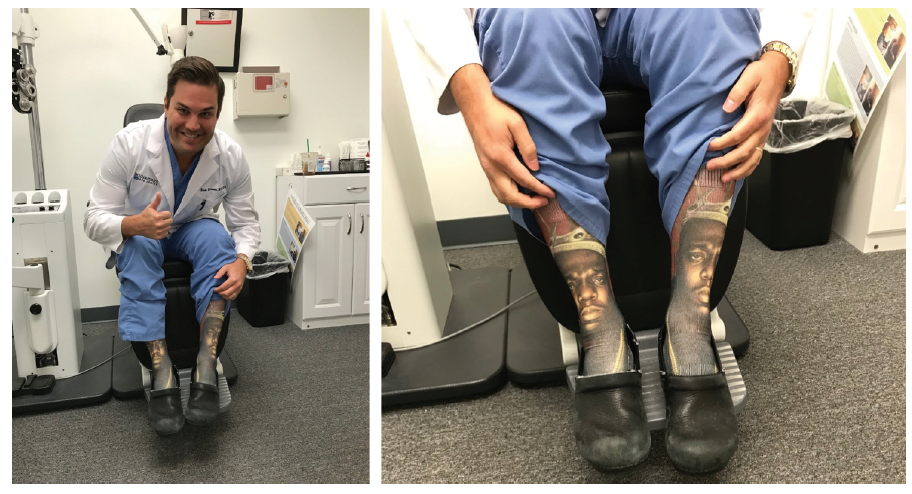
Figure 1. Dr. Williamson lets patients see his goofy side with a social media post featuring his socks.
TWO KEY PLATFORMS
A modern refractive practice really needs to be on two social media platforms, Facebook and Instagram, at a minimum.
Facebook. This platform is the world’s largest social network and the most powerful advertising platform ever invented. What is most important, this is where refractive cataract surgery patients spend a lot of time. When Williamson Eye Center analyzed its Facebook visitors (Figure 2), we found that 75% of people interacting with our content were over age 45 years, relatively few were under age 35, and 80% of them were women. We also learned that the biggest usage spikes occurred at 7 am and 10 pm. That tells us a lot about how to target our ads and when to post new content.
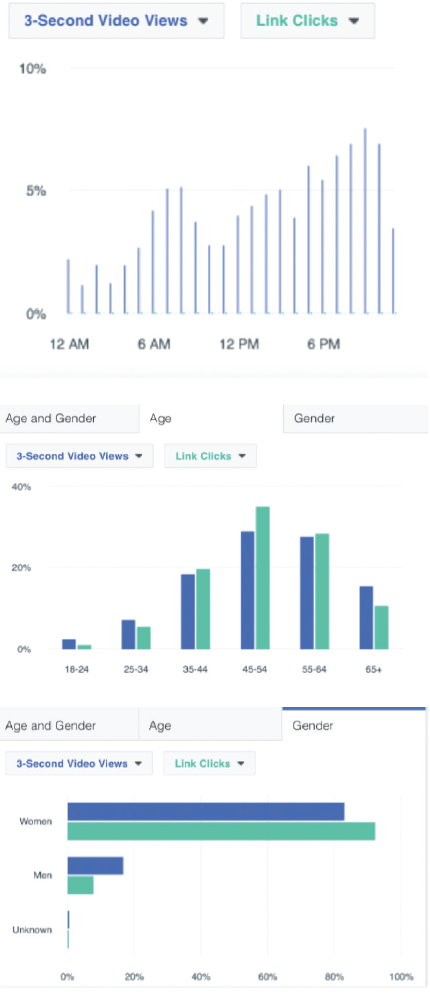
Figure 2. An analysis shows the age and sex of the practice’s Facebook followers and the times of day they are most active online.
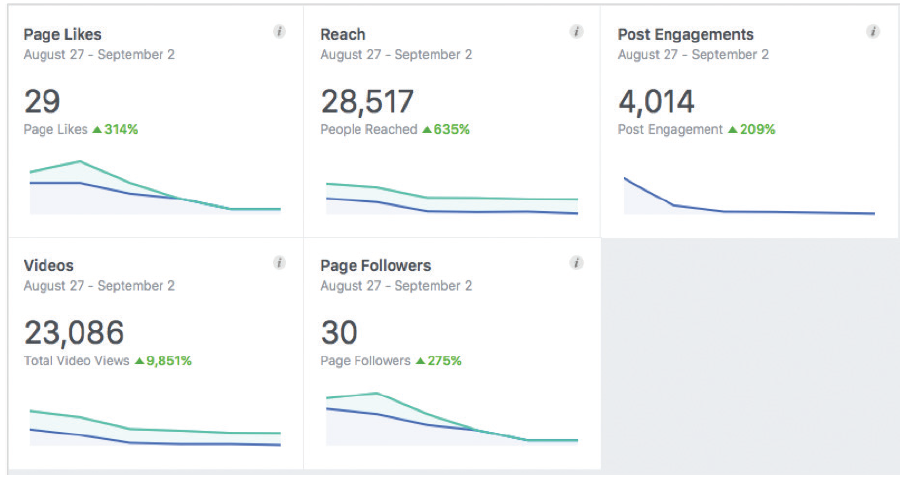
Figure 3. A week-to-week comparison of Facebook traffic shows increases in page likes and video views, among other metrics, in the week following the practice’s boost of a new video.
We learned that videos—especially live surgery—were our most popular content. (For more on streaming live surgery via social media, see Go Live!) Facebook Live is a great marketing tool. When we were getting ready to perform the first corneal inlay procedure in Louisiana, we did it on Facebook Live. We used a simple smartphone camera to record the case, spent no money on production, and spent US$100 for Facebook to boost the post (Figure 3). The strategy of boosting a post allows someone to push it out to more people. The video got nearly 29,000 views and was shared by 100 people. It brought in 19 prospective patients for consults, which ultimately resulted in 10 procedures (six inlays, two refractive lens exchanges, one laser cataract surgery, and one LASIK procedure).
Go Live!
By Blake K. Williamson, MD, MPH, MS
One of the best ways to build awareness and to capture the attention of existing and potential patients is to stream live surgery on Facebook Live and on Instagram Stories (Figure). Individuals who already follow me on Instagram, for instance, will receive a notification that says, “williamsonlasik is live,” prompting them to watch the video before it’s over.
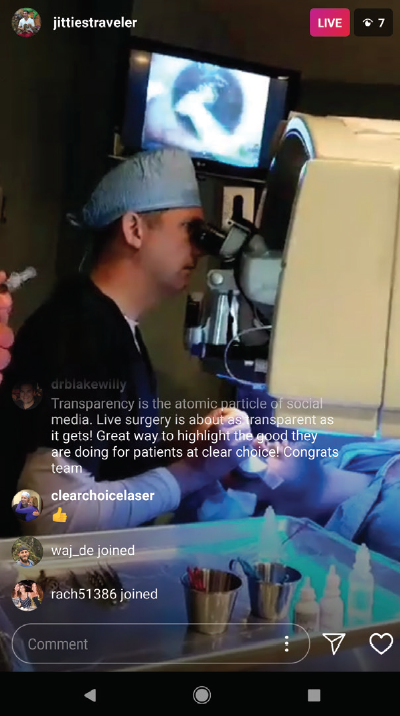
Figure. Screenshot of live surgery performed at Clear Choice Custom LASIK in Cleveland, Ohio and streamed on Instagram Stories.
I tend to post live surgery on Instagram Stories, especially on LASIK surgery days, which occur every other Friday. On those days, someone in the OR films the surgery with my phone and streams it live. To complement the live stream video, I also post other stories that include boomerangs, videos, pictures, and text. At the end of the series of stories is a call to action; it will include our novelty telephone number (1-888-54-LASIK) and the LASIK surgery dates for the following month.
One of the benefits of using Instagram Stories is that this content is at the top of the app, and it is in chronological order. Hands down, the best way I get seen as a surgeon is Instagram Stories. I can’t be sure that people will see my Instagram posts in their feeds, so posting stories, including live surgeries, ensures that at least your current followers will see it—and potentially more people in your community, too.
The game is changing. All of the social media platforms know that people want video. They want transparency, and transparency is like the atomic particle of social media. Nothing is more transparent than doing something live.
Instagram. This is where LASIK-age patients live. Chances are, however, that your patients didn’t go on Instagram today with the intent to find a LASIK surgeon, so you have to grab their attention within seconds.
We love to capture the post-LASIK clock test, when the patient sits up on the table and tells us what time it is from the clock on the wall across the room—the same clock he or she couldn’t see preoperatively. We did this recently with a patient who was thrilled with his procedure. It was a short, quickly made video that we posted to our Instagram Stories. Because all the women on the office staff found this patient attractive, we decided to target our boost to women ages 18 to 39 with at least some higher education and earning more than $50,000 per year. The video ended with a call to action, saying, “Our next available LASIK is April 20th.”
MORE EXAMPLES OF HOW TO DO SOCIAL MEDIA RIGHT
- Digital assistants such as Siri (Apple) and Alexa (Amazon) are becoming ubiquitous, which means that voice may soon be the new search medium. Create content that is applicable for voice, such as podcasts or Facebook Live.
- Host a webinar on Facebook Live. Patients can type in their questions and the surgeon can answer them live.
- Use Facebook Messenger to replace the chat feature on your website. This takes advantage of an easy, familiar platform that patients are already using actively.
- Give away a lead magnet such as a guide to the “Top 10 Questions You Should Ask Before Choosing a LASIK Surgeon.” Ask patients to type “yes” in the comments box on your Facebook page in order to have this quick digital resource sent to them automatically through Facebook Messenger.
- Get your staff members involved in creating a fun video using the Instagram Boomerang app. The app combines photos into short action videos that play forward and backward in a loop.
- Remember that local news is your friend. When you launch a new technology in the practice, call local (traditional) media and ask to be featured on their social media pages, which might have 100,000 followers.
In another post, we promoted Friday LASIK, which we plugged as a way for patients to transform their vision without missing work (Figure 4). These are the kinds of easy but powerful posts and Instagram Stories we should all be posting regularly.
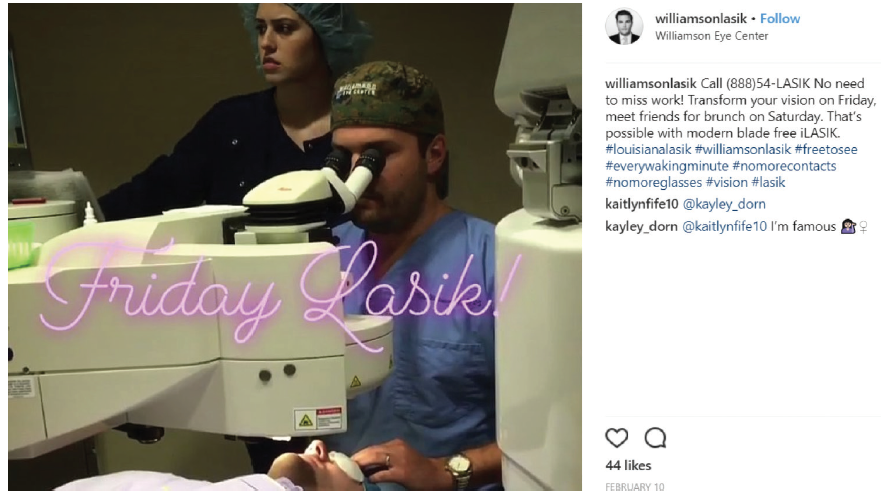
Figure 4. This Instagram promotion appealed to millennials who brunch and who don’t want to miss work.
THE LASIK DECISION CYCLE
In marketing lingo, the buy cycle consists of the stages that consumers go through as they become aware of a need; identify that a product exists to meet their need; consider all the options or features that may affect their purchase; and, finally, make the purchase. The decision to have LASIK has a long buy cycle—anywhere from 6 to 24 months.
Here are three reasons LASIK patients extend this cycle toward the longer end, or perhaps never reach the purchasing stage at all.
Reason No. 1: They don’t trust you. Social media, by helping you share stories about yourself, your practice, and your staff, can actually help you combat this perception and build trust.
Reason No. 2: They don’t trust themselves. This goes back to what we mentioned earlier, the resonance of messages around friends and family supporting a decision. You can address this by, for example, featuring family members talking about the impact of surgery on a loved one.
Reason No. 3: They have all the time in the world. This is why promotions or a social media call to action should have an expiration date. Creating scarcity prompts patients to make, rather than delay, a decision.
Conclusion
By posting engaging content that tells stories, targets your patients where they spend their time, and addresses their real fears and barriers, you can be successful in using social media to market your refractive practice.




